

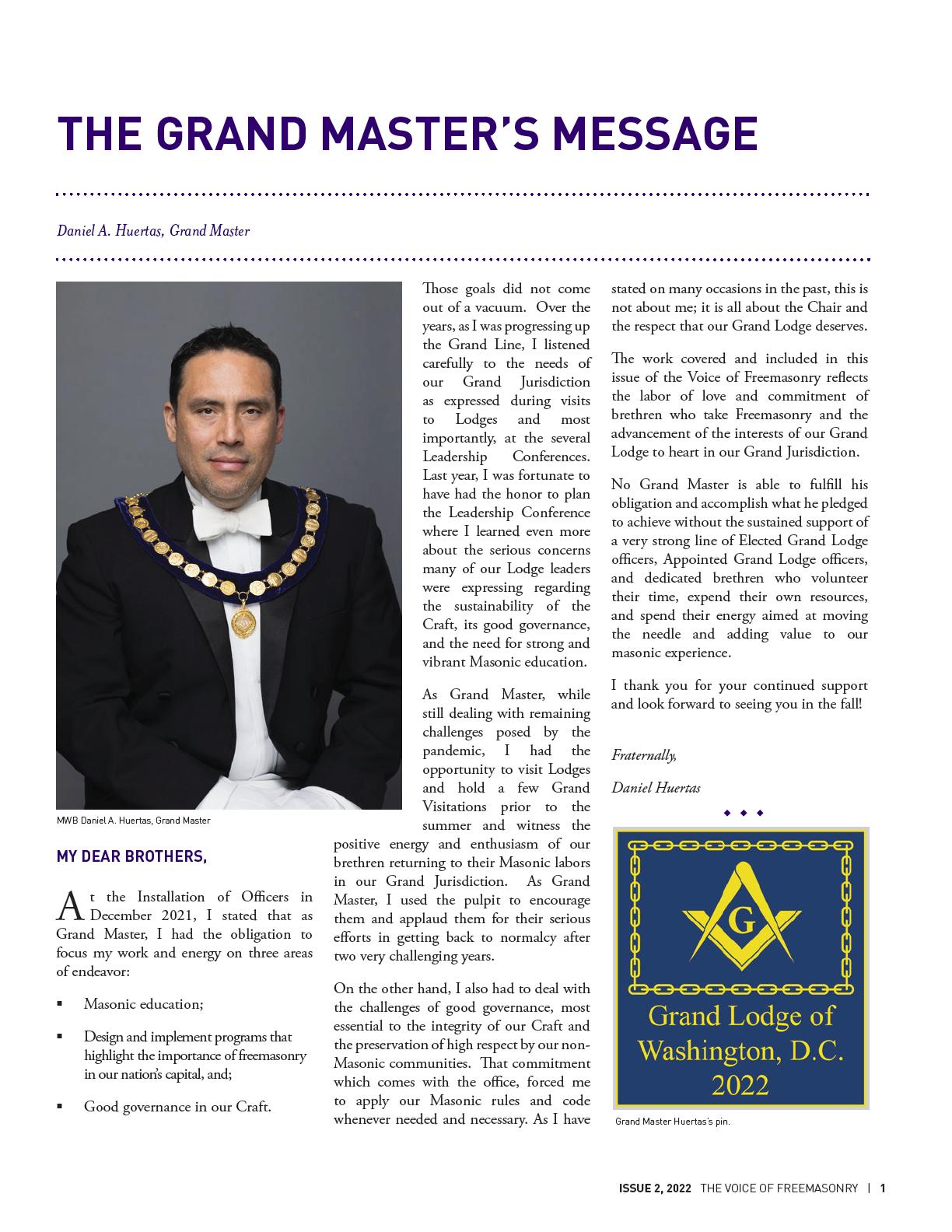

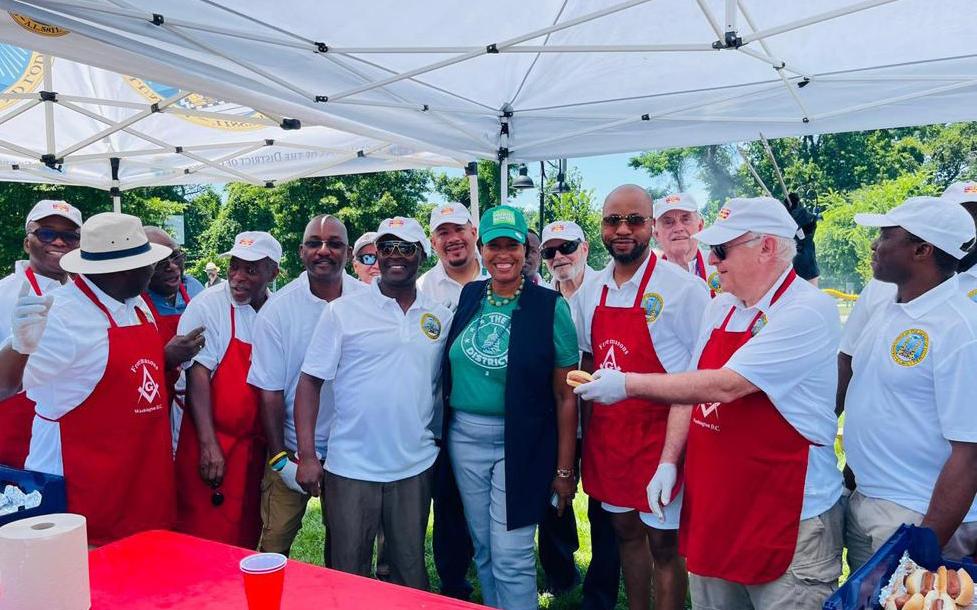


ISSUE 2, 2022 THE VOICE OF FREEMASONRY | 3
Members of the Grand Lodge pose with Hon. Muriel Bowser, Mayor of DC

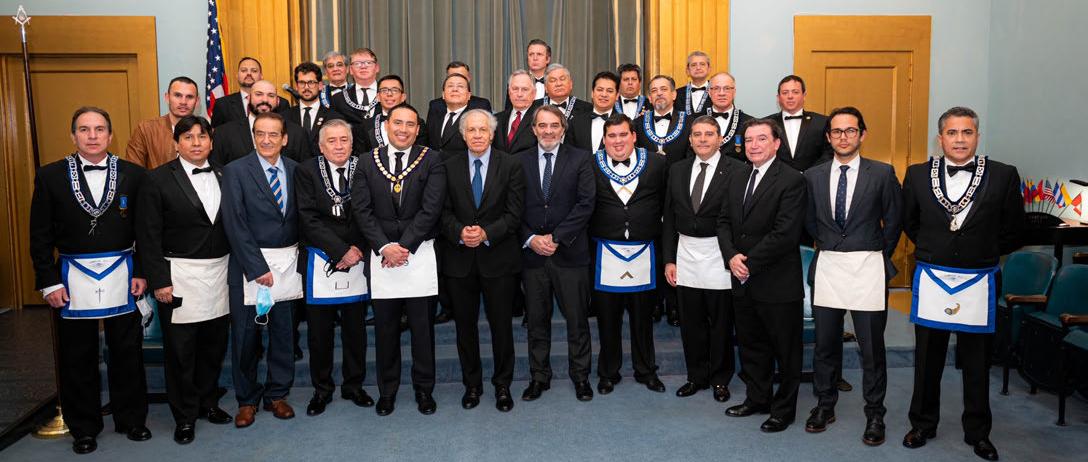

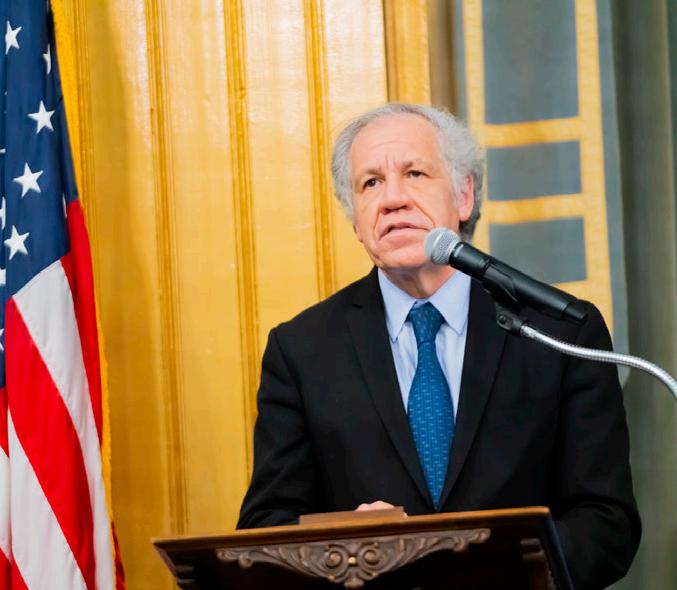


ISSUE 2, 2022 THE VOICE OF FREEMASONRY | 5
The Grand Master with PGMs. Charbel T. Fahed, Leonard Proden, Richard J. Bautista, Akram R. Elias
The Grand Master addressing the Brethren at Compass Lodge No. 1811 Music - One of the 7 Liberal Arts and Sciences
The Secretary General of the Organization of American States (OAS), the Honorable Luis Almagro
The Grand Master being escorted to the East
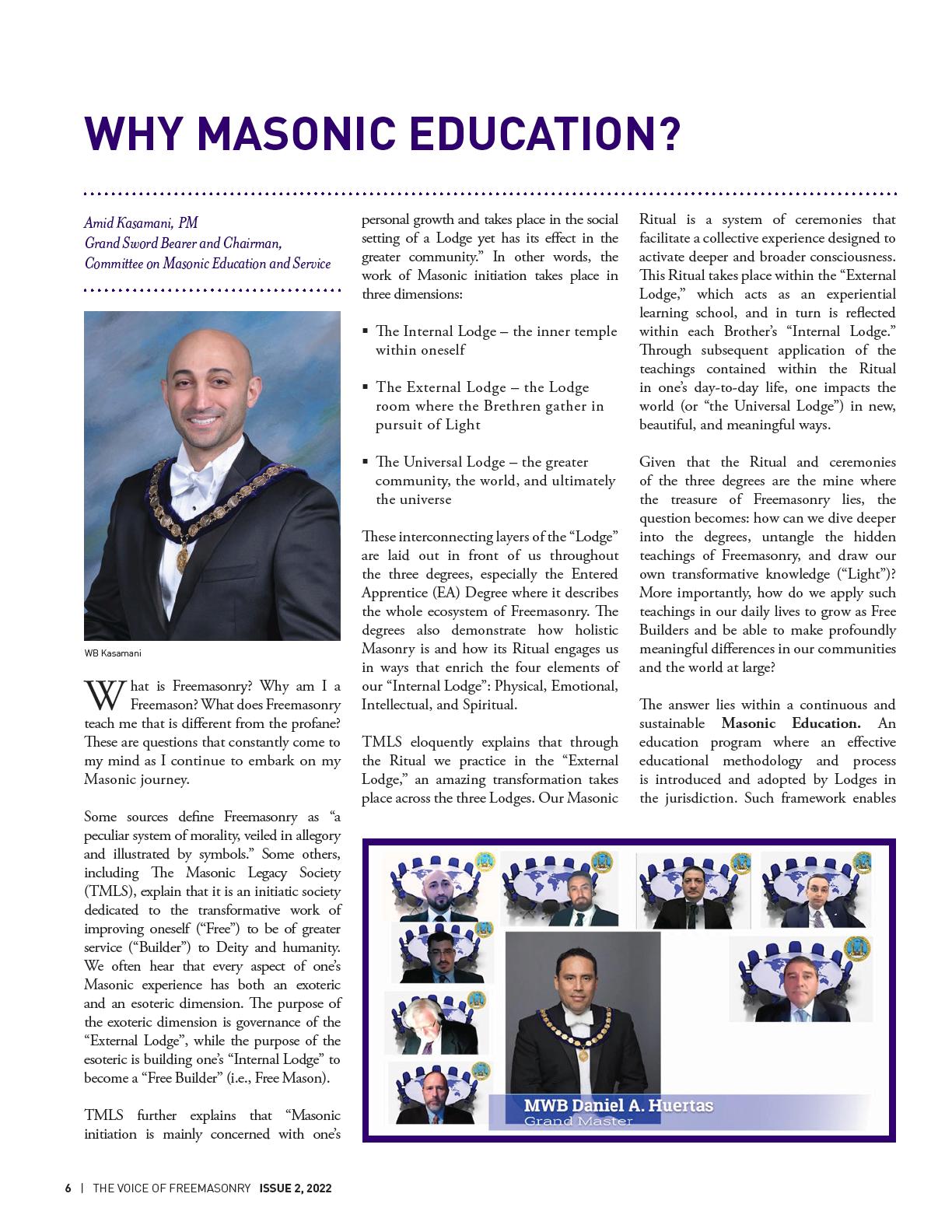

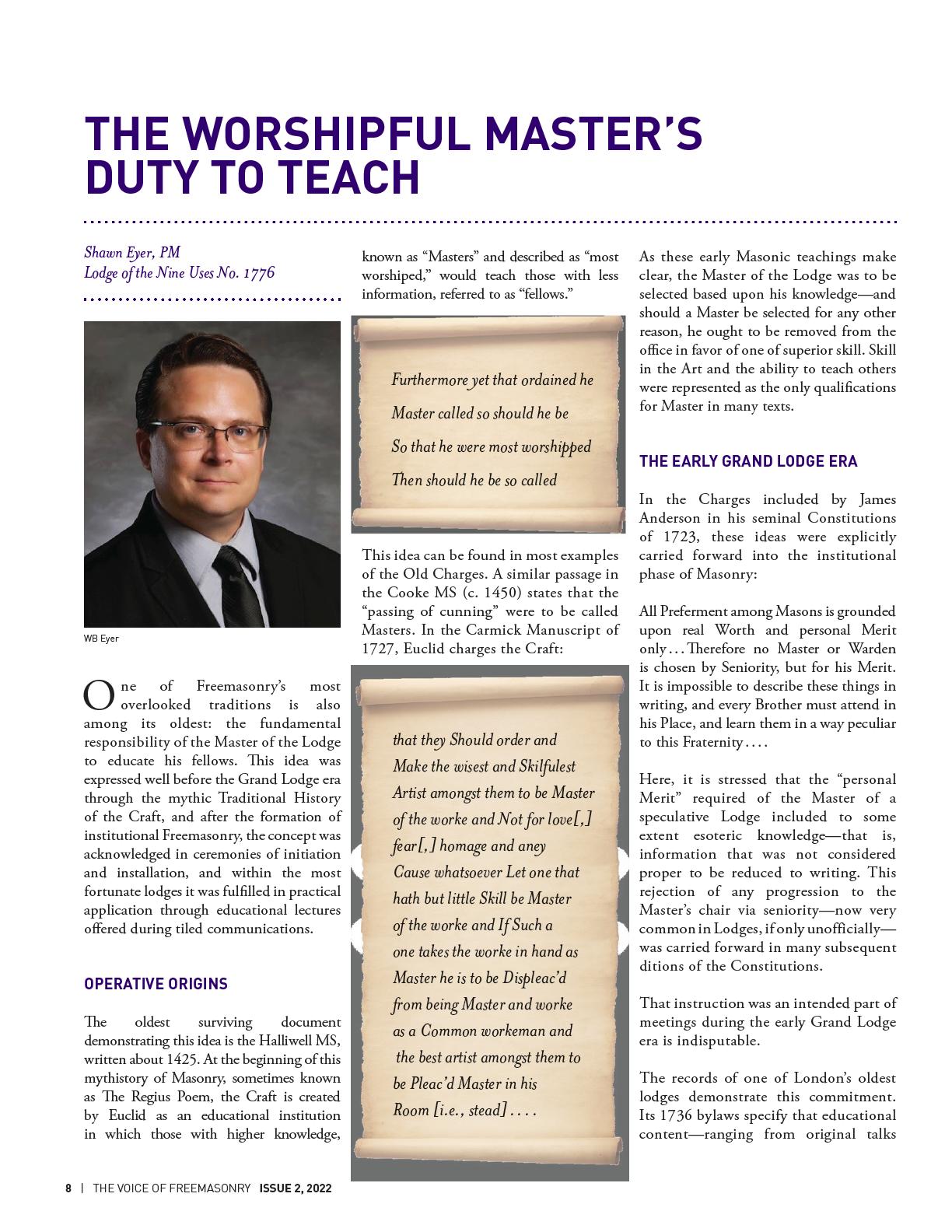
and debates, to recitations from the Constitutions, to the catechetical lectures—was required, and the lodge could punish its leaders who failed to deliver. The catechisms were to be taught by the Master “on ev’ry Lodge night, or y[e] person in ye Chair so neglecting shall forfeit a Bottle of Wine to be drank by ye Brethren, after the Lodge is clos’d, to make them some part of Amends for ye Omission.” It is clear from the bylaws and minutes of that lodge that their Master’s constant duty was to arrange lodge communications in which ideas where shared and traditional Masonic lore was articulated and contemplated.

THE INSTALLATION CHARGE
In 1767, Wellins Calcott crafted a beautiful Charge for the installation of the new Master of the Palladian Lodge (No. 290, Moderns). This Charge contains language that is familiar to most American Freemasons. It eloquently reinforces the three essential duties of the Master: to be moral (illustrated by his “ensign,” the Square, and by his devotion to “the sacred volume”), to be just in following the laws of Masonry, and to educate the brethren (illustrated by his symbolic identification with the Sun). All three of these points are reflective of an instructional mandate.
Calcott describes the Square as the particular symbol of the Master in terms rooted in the Masonic literature of the founding generation: “be it ever in your thoughts, that the ancients particularly held this symbol to be a just, a striking emblem of the divinity. They said, the gods, who are the authors of every thing established in wisdom, strength, and beauty, were properly represented by this figure,” which ought to “ever remind you of your duty both to God and man.”
Next, Calcott’s charge reminds the Master that he must live by and enforce the laws and regulations of Masonry. The questions put to the Master prior to installation reflect this important duty. A Master who does not support the
Landmarks of Masonry or the regulations of the Craft in general will not be able to properly teach others how to do so.
Finally, Calcott illustrates the Master’s educational responsibility by comparing it to the sun’s purpose to diffuse light:

the north and his face to the east, the initiate stands ready to receive Masonic Light and instruction from the Master.
That the educational mandate expressed in Calcott’s Charge was understood by American Freemasons is evidenced by the regulations of South Carolina’s Ahiman Rezon of 1807, which stated that “It is not alone sufficient” for lodge Masters to be “honest, good men; but they must be well acquainted with the principles and doctrines of the craft, and be able to teach them . . . .” The 1822 edition of the same work puts it concisely: “He will, in short, speak upon literary and scientific subjects as a Master.”
A RETURN TO TRADITION
The association of the Master with the symbol of the rising Sun is among the most universal Masonic traditions. As the candidate seeks Light, it is generously bestowed by the Master. In fact, the three principal officers are all associated with positions of stations of the Sun, and are Masonic symbols unto themselves. That the associations between the three principal officers and the stations of the sun are deeply embedded within the ritualistic praxis of Ancient Craft Masonry is easily demonstrated. They are referenced at the opening and closing of every communication. The north represents low twelve and the near absence of light. The East represents the dawn and the first fiery darts of light, followed by the glorious sunrise. Between these two points, with his back to
Although during the twentieth century it was not uncommon for the Master to be re-conceptualized as a corporate “chief executive” who was by definition too busy to deal with the task of educating his brethren, this model went against the grain of Calcott’s Charge to the Master and resulted in the denigration and neglect of Masonic education within the majority of lodges.
Today, many who wish to return to the traditional design of the Craft may rely upon the symbolism associated with the Master’s office—namely, the emblem of the Square and his identification with the rising Sun—to restore the educational mandate of the Master and to reorient the instructional activities of the Lodge. The Square is used “to bring rude matter into form.” The Apprentice Mason, symbolized by the Rough Ashlar, is brought to the Master to receive knowledge. In relative darkness, he beholds the Light of the symbolic Sun through the medium of the Master, and hears his words of luminous instruction.
ISSUE 2, 2022 THE VOICE OF FREEMASONRY | 9
For a pattern of imitation, consider the great luminary of nature, which, rising in the east, regularly diffuses light and lustre to all within its circle. In like manner it is your province, with due decorum, to spread and communicate light and instruction to the brethren of the lodge.
The Worshipful Master, from Duncan's Ritual And Monitor of Freemasonry,1866

With Masonic ancestors to lean on, I took a deep calming breath – pulled the room into focus and called out to our Brethren. Fumbling at first to find my voice in this vast room, I finally laid down the printed ritual pamphlet—and took the room’s inner reins as we walked through the ritual—”Vivat!, Vivat!, Vivat! – to the good fire!“ began echoing through the great hall. As the energy rose, and Brethren realized that they too were shedding the lingering COVID dust –our living Masonic Temple began to take shape. Each Lodge giving life energy to fill the hall – finding even the farthest columns and pilasters. New

Entered Apprentices eagerly offering to read passages on the familiar symbolism of the Fork, the Knife, and the Tumbler. Worshipful Masters and Grand Lodge Officers rediscovering their familiar roles— bathing in the Masonic Safe Space—wiling to stumble in their enthusiasm knowing that the Brethren were there to catch them and help carry the moment forward.


By night’s end, the last calls of “Auld Lang Syne” had finally echoed away—the Brethren lingered there unwilling to let go of the evening - soaking up the in person fellowship that we all love. The parking
lot offering one last shaking of hands, waves to departing cars, and wishes for health and safe travels.
The next morning my 11-year-old son entered the kitchen— “Daddy we heard you up early and singing—what are those songs?” I knelt down and embraced him, “They are the melodies of Brotherly Love, Relief, and Truth” — and I pray that someday you find yourself singing these melodies to your children.

ISSUE 2, 2022 THE VOICE OF FREEMASONRY | 11
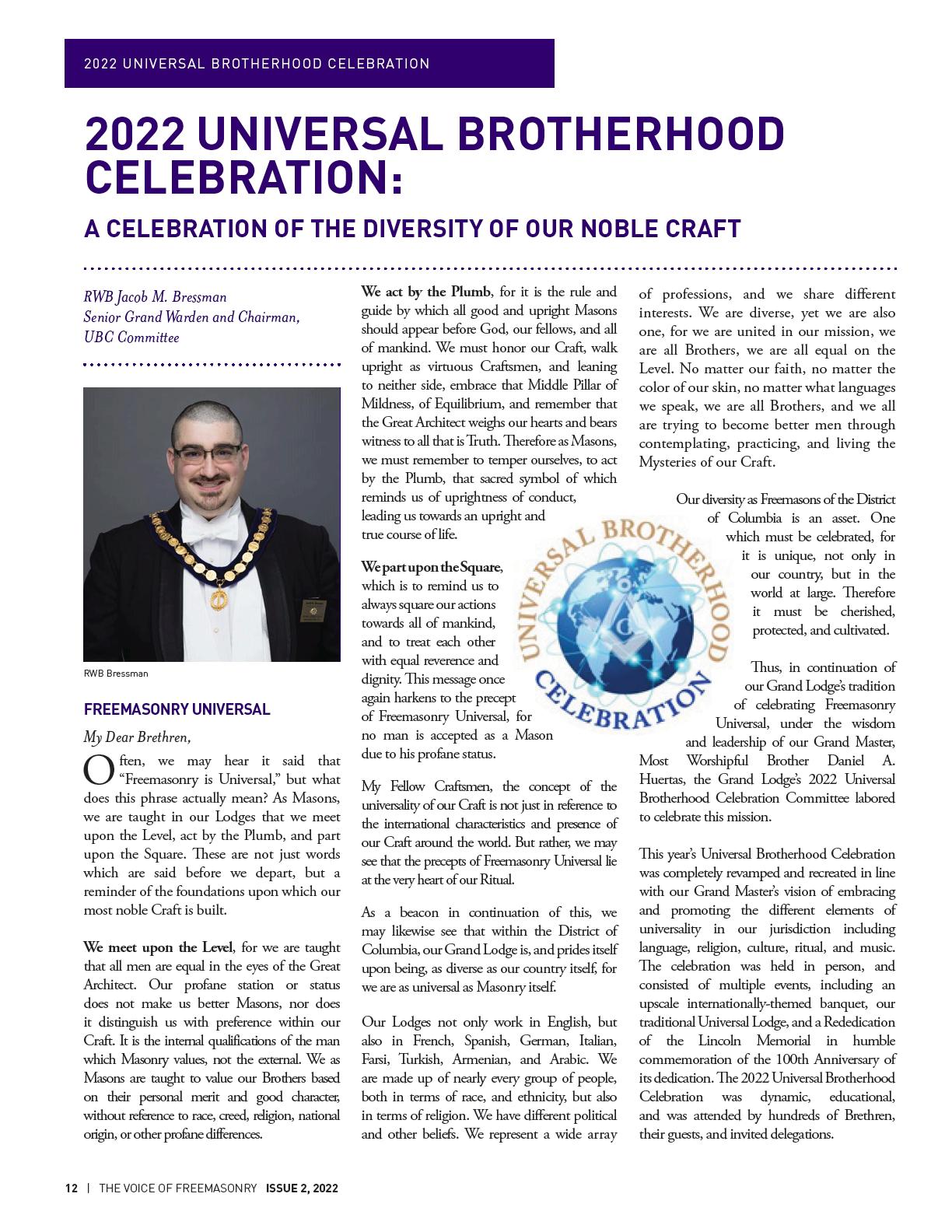
LINCOLN MEMORIAL REDEDICATION EVENT
In humble commemoration of the 100th Anniversary of the dedication of the Lincoln Memorial, on Friday, June 10, 2022, the Grand Master of Masons of the District of Columbia, Most Worshipful Brother Daniel A. Huertas, alongside Most Worshipful Brother Anthony B. Corbitt, Grand Master of the Most Worshipful Prince Hall Grand Lodge of the District of Columbia, gathered for a public Masonic procession at the Lincoln Memorial as accompanied by the United States Air Force Brass Quintet.
Led by the distinguished Bagpiper, Mr. Wayne Francis, representatives from each respective Grand Lodge, and accompanied by distinguished guests, processed from above the Reflecting Pool to the steps of the Lincoln Memorial, a most important symbolic Temple of Democracy for our Nation. With over 50 Brethren, and many invited guests present, the Colors were presented by the

Joint Armed Forces Color Guard, which was accompanied by the Pledge of Allegiance, as delivered by COL Worshipful Brother Robb Mitchell, US ARMY, Retired, and was followed by the National Anthem, as sung a capella by the renowned mezzo-soprano Ms. Anamer Castrello.

Opening remarks were delivered by Most Worshipful Brother Akram R. Elias, PGM, which were preceded by the Invocation, as delivered by Right Worshipful Brother Annas F. Kamara, Deputy Grand Master. Masonic Wreaths were presented before the Statue of Abraham Lincoln by the Grand Master of Masons of the District of Columbia, and by the Grand Master of the Most Worshipful Prince Hall Grand Lodge of the District of Columbia, on behalf of their respective Grand Lodges. Following the presentation of wreaths, both Grand Masters delivered their remarks.
In addition to elected and appointed Grand Lodge Officers of both of Washington,

D.C.’s Grand Lodges, and members of the Appendant Bodies and Constituent Lodges each respective Grand Lodge, this historic event was attended by several visiting Brethren and distinguished guests, to include, Most Worshipful Brother Richard Maggio, Grand Master of the Grand Lodge of Massachusetts and Honorary Past Grand Master of the Grand Lodge of Washington, D.C., F.A.A.M., Most Worshipful Brother Jeffrey Haass, Jr., Grand Master of the Grand Lodge of Delaware, Right Worshipful Brother Stephen Tucker, Deputy Grand Master of the Grand Lodge of Delaware, and Right Worshipful Brother Andre Faria, Jr., Senior Grand Warden of the Grand Lodge of Rhode Island, among others.
The event was expertly orchestrated and choreographed and was witnessed by numerous members of the general public.
ISSUE 2, 2022 THE VOICE OF FREEMASONRY | 13
Group Photo at the Lincoln Memorial.
The Joint Armed Forces Color Guard presents the Colors. Ms. Anamer Castrello sings the National Anthem
2022 UNIVERSAL BROTHERHOOD CELEBRATION










18 | THE VOICE OF FREEMASONRY ISSUE 2, 2022
The Craft Gathers at the Reflecting Pool.
The Brethren Prepare for the Presentation of Colors.
Public Masonic Procession at the Lincoln Memorial.
Group Photo at the Lincoln Memorial.
2022 UNIVERSAL BROTHERHOOD CELEBRATION
The two Grand Masters present Masonic Wreaths at the Statue of Abraham Lincoln.






20 | THE VOICE OF FREEMASONRY ISSUE 2, 2022
The Grand Master Recognized Past Grand Masters of our Grand Lodge.
Worshipful Brother Tabbert Signs Copies of his New Book for the Brethren.
The Brethren Enjoy Fellowship Following the Universal Lodge.
The Grand Master Delivers his Closing Remarks.
2022 UNIVERSAL BROTHERHOOD CELEBRATION
The Grand Master Receives Invited Visiting Delegations.



ISSUE 2, 2022 THE VOICE OF FREEMASONRY | 21
The Grand Master, Most Worshipful Brother Daniel A. Huertas, is received at the Altar of the Universal Lodge.
Right Worshipful Brother Jacob M. Bressman, Senior Grand Warden, is received by the Master of the Universal Lodge.
2022 UNIVERSAL BROTHERHOOD CELEBRATION
The Brethren Gather to Tile the Universal Lodge.




22 | THE VOICE OF FREEMASONRY ISSUE 2, 2022
The Grand Master Recognized Past Grand Masters of our Grand Lodge.
The Color Guard Presents the Colors.
The Deputy Grand Master Delivers his Remarks.
2022 UNIVERSAL BROTHERHOOD CELEBRATION
The Deputy Grand Master, Right Worshipful Brother Annas F. Kamara, is received in the Universal Lodge.







widow, Anne Fairfax, and their young daughter, Sarah. All this occurred while he remained obliged to look after his mother, Mary, and his younger siblings living in Fredericksburg.
During that summer, a dozen or so men in Fredericksburg organized a Masonic lodge. Many of these men were tobacco merchants who had joined the Craft in Scotland. But there were Freemasons in the area from other places with other trades—including soldiers. If Washington had met Freemasons on Barbados, it is reasonable that upon hearing of the lodge, he sought admission.7
. . . George Washington joined Freemasonry in the Lodge at Fredericksburg, Virinia, through three progressive ceremonies, or degrees. He was initiated an Entered Apprentice on November 4, 1752. Four months later, on March 3, 1753, he was passed to the second degree of Fellow Craft. On August 4, 1753, he was raised to the third degree of Master Mason. He remained a member of this lodge for the rest of his life . . . 8
. . . Freemasonry’s initiation ceremonies, along with its so-called secret grips and words, have appeared in print since the 1720s, but the exact version of the ceremonies Washington received is unknown, as the Lodge’s minutes include no descriptions.9 The printed version that probably comes closest to the ceremonies Washington received appeared in the 1760 exposé Three Distinct Knocks. Although published in London eight years after Washington’s initiation, the seventytwo-page pamphlet scripts the Masonic rituals most common in Irish and English “Ancient” lodges as well as in many Scottish lodges in the 1750s.10
The lodge opened with Washington (the candidate) outside in a waiting room. There, he was divested of his worldly possessions and blindfolded (or hoodwinked). His conductor led him to the lodge door where he was required to make three distinct knocks. The door opened, and a lodge officer asked several questions that either Washington, or his conductor, answered. With the permission of the Master, he was
received into the lodge room. A prayer was given and his conductor then led him around the room, so all present could identify him and affirm he was properly prepared for initiation. He was then taken to the lodge’s altar and caused to kneel. With his hands touching a Bible, Washington took upon himself an obligation recited to him by the Master. The obligation was essentially a promise to keep Freemasonry’s secrets and uphold its constitutions.11
The obligation complete, the hoodwink was removed as the brothers gave a surprising clap. The Master then greeted Washington as a Masonic brother and presented to him a white lambskin apron. Then and now, the apron is the badge of a Freemason and must be worn when in a lodge meeting. He was also taught the grip and word of an Entered Apprentice.
According to Three Distinct Knocks, Washington was then likely shown a group of hand-drawn images from the Bible and of stonemasons’ tools, probably drawn in chalk on the floor, but possibly painted on a wood panel. This instructional chart, or “tracing board,” would guide Washington as the lodge lecturer explained the symbolic meaning of his initiation. The lecture also explained the importance of the five senses of human reason and the seven liberal arts and sciences—especially geometry. Once the lecture finished, Washington was reconducted to the anteroom where he recovered his worldly possessions. . .
. . . It remains unknown what Washington thought of the three degrees he received, or if they made any lasting impact upon him. The months between his initiation in November 1752 and his attendance at the first meeting after he was raised to Master Mason in September 1753 were a pivotal time. In December 1752, he came into sole possession of Mount Vernon when his sister-in-law and niece moved to the Fairfax estate. In February 1753 he passed his twenty-first birthday and was appointed the Virginia Adjutant General for the Southern District with a rank of major.12
In November 1753, Virginia Governor Robert Dinwiddie appointed Washington
to carry a message to the French forces in western Pennsylvania. A great adventure was before him. In the fourteen months that followed, Washington gained honor leading expeditions to western Pennsylvania, but also suffered defeat at Fort Necessity, before he reappeared in Fredericksburg Lodge on January 4, 1755. His childhood was then far behind him and before him was a promising future of active military service. Like so many other men, Washington’s Masonic initiation marked one of the last passages from boundless youth into dutiful manhood.
This excerpt was orginially published in The George Washington Masonic National Memorial Association “Light” 27:1, 5-6
WORKS CITED
1 Richard A. Rutyna and Peter C. Stewart The History of Freemasonry in Virginia (University Press of America 1998), 32-34.
2 Johnson, Beginnings of Freemasonry, 117. Kent L. Walgren, Freemasonry, Anti-Masonry and Illuminism in the United States: 1734-1850: A Bibliography. 2 vols. (Worcester, MA: American Antiquarian Society, 2003) v.1, 5.
3 There is no evidence Lawrence Washington was a Freemasons, but he may have meet Freemasons during his education in England in the early 1730s or during his military service in the 1740s. He named his estate Mount Vernon after Admiral Edward Vernon (1684–1757). Adm. Vernon’s father, James (1646–1727) was secretary of state under William III and an important English Freemason. James Vernon was instrumental in the creation of the colony of Georgia. See Ric Berman Loyalist and Malcontents: Freemasonry in South Carolina and Georgia (UK: Old Stable Press, 2018), 112.
4 There is no evidence of members of the Virginia Fairfax family were Freemasons. There were Freemasons among a collateral Fairfax family, in York, England, descended from Sir William Fairfax (1609–1644). Thomas Bowman Whytehead “The Grand Lodge at York” Ars Quatuor Coronatorum, II, 110-114. See also David Harrison The York Grand Lodge (UK: Arima Book, 2014)
5 Jack D. Warren, Jr., “The Significance of George Washington’s Journey to Barbados,” Journal of the Barbados Museum and Historical Society 47 (2001): 6. 41. Alicia K. Anderson & Lynn A. Price, eds., George Washington’s Barbados Diary, 1751-1752. (Charlottesville: University of Virginia Press, 2018).
30 | THE VOICE OF FREEMASONRY ISSUE 2, 2022
6 John Lane, Masonic Records, 1717-1894; Being List of All the Lodges at Home and Abroad Warranted by four Grand Lodges . . . . (London: E. Letchworth, 1895), 86, 95, 97. https://www.dhi. ac.uk/lane/howtoread.php
7 Ronald Heaton & James R. Case, The Lodge at Fredericksburgh: A Digest of the Early Records. (Bloomington IL: Pantagraph Publishing, 1975), 1-4. Walker, J. Travis. A History of Fredericksburg Lodge No. 4, A.F. & A.M., 1752-2002, (Fredericksburg VA: Sheridan Books Inc., 2002), 1-3.
8 Proceedings if the Grand Annual Communications of the Grand Lodge of Virginia, Begun and Held in the Masons’ Hall, in the City of Richmond, on Monday the Eight Day of December, A.L. 5800A.D 1800. Richmond: Brother John Dixon, 1800. 34.Necrology of departed brothers 1799-1800 lists him as a brother of Fredericksburg Lodge no.4.
9 Samuel Prichard. Masonry Dissected (London, J. Wilford, 1730). The first American edition of which was published in Rhode Island ca. 1749, see Walgren, Bibliography, v.1, 6. Exposures of the Masonic rituals appear in London newspapers in the mid-1720s. See S. Brent Morris, “The Post Boy Sham Exposure of 1723” Heredom: The Journal of the Scottish Rite Research Society, v.7, 1998, 9-38 and Douglas Knoop, G.P. Hamer, and Douglas Jones. Harry Carr, ed. The Early Masonic Catechisms. 2nd Ed. (London: Quatuor Coronati Lodge, No. 2076, 1975). Regardless of what exact words and actions were taken, the quantity and consistency among the exposures provide sufficient evidence to reconstruct and strong representation of what Washington witnessed in the Lodge at Frederickburg.
10 Harry Carr, Three Distinct Knocks and Jachin and Boaz 1760 and 1762. Reprint (2 vols. in 1). (Bloomington, IL: The Masonic Book Club, 1981) 70. The book’s title alludes to the way all men gain admission to a lodge; first by seeking a Freemason, then by asking a member to sponsor, or vouch for him, and finally, by knocking on the lodge door and refers to Matthew 7:7. Carr wrote: “That Freemasons widely condemned this exposé reveals how close it was to the actual ‘secret” work.”
11 Heaton & Case, The Lodge at Fredericksburgh, 58-59.
12 Freeman, Young Washington, 266-273. Peter Stark, Young Washington: How Wilderness and War Forged America’s Founding Father (NY: Harper Collins, 2018), 32-34, 181-182.
UPCOMING EVENTS:
Grand Visitations
(all held at the George Washington National Masonic Memorial):
• September 23, 2022
Lodges – 4, 11, 21, 35, 76, 98, 1717, 1821, 3000
• September 30, 2022
Lodges – 6, 14, 32, 47, 94, 925, 1002, 1003, 1776, 2000
• October 14, 2022
Lodges – 5, 10, 19, 34, 25, 90, 222, 1001, 1775, 1893
• August 27-28
Grand Lodge Leadership Conference – at The Bolger Center
• September 17
Grand Lodge Picnic
• October 28th
Masquerade Ball
• November 12 Masonic Day of Thanksgiving
• November 19
The Annual Communication of Grand Lodge – 10:00 a.m. at Almas Shrine Center
ISSUE 2, 2022 THE VOICE OF FREEMASONRY | 31
UNCOVERING THE SECRET OF THE MUMMY
Two massive limestone sphynxes guard the Scottish Rite of Freemasonry’s House of the Temple in Washington, D.C. These stone creatures, completed in 1915, are a testament to the fascination Ancient Egypt has held on the human imagination for centuries. We know, for example, that the Egyptian goddess Isis was worshipped over large areas of the Greco-Roman world well into the Christian era. Later, during the early 1800s, the Egyptian hieroglyphics were decoded following the discovery of the Rosetta Stone, rekindling an interest in this mysterious ancient land and its culture in both Europe and America. Egyptian themes from antiquity found their way into Masonic ritual, architecture, and libraries—as we will see in the following article and translation by Dr. Mark Dreisonstok, P.M., Arminius Lodge No. 25. Needless to say, the Scottish Rite’s foundational Morals and Dogma book is also keenly aware of Egyptian philosophy.
– John M. Bozeman, Ph.D.

as well. I could not fail to notice a beautiful 1886 book with ancient Egyptian stylistics on the gilded cover called Das Geheimnis der Mummie (The Secret of the Mummy) by August Niemann (Bielefeld and Leipzig: Belhagen und Klasung Publishers). The first few pages of this rather obscure German novel in my translation go something like this:

From the banks of the Nile, a company of travelers moved from the Biban-el-Moluk valley, a mountain chain in the West of the holy stream. They had visited Thebes and had observed and been impressed with the splendor and magnificence of the ruins of public monuments, sanctuaries, and pyramids, even after the weathering of millennia. They then turned their steps towards the tombs.
“I want a real mummy,” Lord Bullamy said, who had financed the journey.
During my time as Managing Editor of the Scottish Rite Journal, I have often perused the books in the House of the Temple’s Goethe Collection, an impressive assemblage of books dominated by the literary, philosophical, and scientific writings of Br. Johann Wolfgang von Goethe (Amalia Lodge at Weimar), donated to the House of the Temple Library in 1935 by Carl H. Claudy (Grand Master, Grand Lodge of the District of Columbia, 1943). However, this collection contains other rare volumes
Lord John Bullamy had many possessions. He was one of the wealthiest lords in the United Kingdom. His holdings included palaces and parks in England, Scotland, and Ireland, houses in the West End of London, fine horses, and a gallery of famous paintings—he had almost everything money could buy.
Yet Lord Bullamy was bored. He had given up the hunt and the races, for they were simply boring to him. He no longer visited his palaces and parks and did not make his appearance during London’s social season.
A friend suggested that he take a wife, but Lord Bullamy responded only that this would also be very boring. He had had a yacht built of teak wood and iron and travelled about, so that he might have a change of pace. His yacht was very finely laid out and had every possible amenity. It had a salon of rose-wood and gold, a library well-stocked with the travel works of famous men, and a fine dining room where he drank the finest wines offered from the vineyards of France, Germany, and Spain, in the company of high society.
32 | THE VOICE OF FREEMASONRY ISSUE 2, 2022
WB Dreisonstok
Mark Dreisonstok, PM Arminius Lodge No.25 and Managing Editor, Scottish Rite Journal
Hugh William Williams (1773–1829), View of Thebes. Watercolor. 1819. When we travel, are we indifferent to our surroundings like the haughty English Lord of the 1886 German novel, or do we delight and find inspiration in details everywhere around us? Source: Wikimedia Commons.


(number 1) and all odd numbers. The famed occultist, René Schwaller de Lubicz, discovered this same “Temple in Man” after 15 years of his own in-depth research and measurement at the Luxor Temple in Egypt. Like our Middle Chamber, de Lubicz found that “creation is accomplished entirely between the numbers One and Two; and duality is the basic characteristic of the created Universe.”
Turning back now to our initial Qabalistic code, Berashith (בראשית), we find that the second letter Resh (ר) translates to “head.” Once the logos is decapitated, the remaining letters (באשית) can be arranged to form the word Shabbatai (שאבתי) which is the Hebrew name for the planet Saturn. But what does Saturn have to do with the Middle Chamber in Man, you ask?
In his infamous depiction of Baphomet, Eliphas Levi included a torch of illumination above the Goat of Mendes— or the Zodiacal Sign of Capricorn. Truth be told, this occult symbol codes many of the same teachings as our own Middle Chamber. Capricorn is an Earth sign which is ruled by Saturn and corresponds to the knees (porchway) in astrology. We also notice the Staff of Hermes (Vav) protruding from the Goat’s groin—an area ruled by the fiery/
energetic sign of Scorpio. Surrounding the Goat’s “rod,” we again find the two nervous systems, Moses’ pole, Boaz and Jachin, Adam and Eve, ad infinitum.

On the Goat’s forehead, Levi chiseled a pentagram—symbolizing the microcosmic man—and Baphomet’s arms and body form the letter Aleph, which translates to “Ox” and alludes to the Earth sign, Taurus. Aleph (א), similarly, corresponds to elemental air in Qabalah and, in that sense, acts as a doula for Taurus’ birthing of the first word noted in the Book of John—or Tetragrammaton. Taken together, Baphomet veils esoteric secrets of the Middle Chamber in Man (microcosm) which are mirrored in the Heavens (zodiac or macrocosm). Freemasonry may conceal this Hermetic axiom through its long association with “riding the G-O-A-T.”


To reintegrate with the G-O-A-T, or “G-AO-T-[U],” the Initiate must travel a rough and rugged road—one beset by Ruffians (fear, envy and lust). This hero’s journey is personified in the death of our Grand Master Hiram Abif. It’s the climbing of Jacob’s Ladder. It’s the battle of good versus evil. A fight against our bestial natures. And it’s an uphill battle so, as the Master Samael Aun Weor teaches, the climbing prowess of the Horned G-O-A-T seems an appropriate metaphor for those doing the Great Work—or the Magnum Opus.
Stated differently, the “temptations of the flesh” stand between the Fellowcraft and his wages. When the initiate rises to the challenge, the Spirit of God moves upon the face of the waters (spinal fluid) and, beyond the Middle Chamber, lies the land of milk and honey (excretions from the pineal and pituitary glands).
This story orignially appeared in SoCal Research Lodge’s Fraternal Review, May 2021.
WORKS CITED:
1. De Lucicz, R.A. Schwaller(1949) The Temple in Man
2. Hall, Manly P. (1929) The Occult Anatomy of Man
3. Weor, Samael Aum (1951) Practical Astrology
ISSUE 2, 2022 THE VOICE OF FREEMASONRY | 35


LAYING THE CASTLE CORNERSTONE: A HISTORICAL REENACTMENT
(Remarks as prepared for delivery)
Hello. I’m honored to be here as the 14th Secretary of the Smithsonian. Today we recreate the auspicious day in 1847 when our first Secretary, Joseph Henry, observed the laying of the cornerstone to the Smithsonian Institution Building, known affectionately as the Castle. It’s apt that his statue watches over the proceedings again. Henry began the tradition of excellence that 13 other Secretaries have upheld and expanded to reflect the changing expectations of the American people.
We gather today to remember what role the Castle has played in our community, our city, and our nation. It’s been a space of


service for 175 years, occupying a spot on some of the city’s most revered land. And when this medieval revival red sandstone building, this homage to nobility, was constructed, it seemed out of place. But it cemented this place as a site of learning, a site of yet to be considered possibilities.
Today, we should also remember that so many buildings in the nation’s capital, like so much of America, were built as the result of conquest, by African Americans enslaved and free. It’s still unclear what role enslaved people played in the construction of the Castle, but it’s clear that Washington, D.C. and the nation would look markedly different today were it not for the efforts of Black laborers.
This day should remind us of that history, too. It’s a history that should be acknowledged so that we can learn from it. Doing so doesn’t
take away from the pride we should all feel for the symbol of enlightenment the Castle has become.
We must use this building to remember that the Smithsonian reflects both the wonders and the reality of American life. Not all who built the amazing landmarks that symbolize the nation benefited from the promise of America. So today, 175 years after the cornerstone for the nation’s Smithsonian Institution was laid, we share a commitment to the American people and the citizens of the world. We use this opportunity not just to remember and revel in our past, but as a challenge to create a better shared future and to live up to the promise of what the Smithsonian can be, one that all Americans deserve.

38 | THE VOICE OF FREEMASONRY ISSUE 2, 2022
Lonnie G. Bunch III
Smithsonian Secretary
The Honorable Lonnie G. Bunch III, Secretary of The Smithsonian
Paying respect to Old Glory View of the U.S. Capitol, a "Temple of Liberty and Sovereignty of the People" (Pierre Charles L'Enfant)
REMARKS BY THE GRAND MASTER

Mr. Secretary, ladies, gentlemen and brethren, be it known unto you that we be lawful Freemasons, true and faithful to the laws of our country, and engaged by solemn obligations to aid in the erection of public buildings by placing in position the foundation-stone, cornerstone, or commemorative stone whenever called upon to do so by those having charge of the same.
These ceremonies which you have witnessed have come down to us from time immemorial, and are in themselves invaluable to us as purely symbolic of that spiritual building which each one of us is engaged in erecting during our natural life; and as in this temporal building, we have proved the stone to be well formed, true and trusty, let each one of us be sure that for his or her spiritual building its foundation stone be likewise well formed, true and trusty.
Mr. Secretary, as Grand Master of Masons who reenacted the laying of the cornerstone of this structure, I now deliver these implements into your hands as a memento of this symbolic, significant, consequential, and inspirational event. (Secretary Buch will approach the podium to take the implements from Grand Master and return to his seat, after which Grand Master continues with his short remarks as follows)
Symbolic, as it entrusts the people who work at this esteemed institution with the charge
to promote prosperity, happiness and peace among mankind.
Significant, as it connects through time this important structure to that of the United States Capitol whose cornerstone was laid Masonically in a similar fashion by President and Freemason George Washington on September 18, 1793. The presence here today of the Gavel used by George Washington to conduct that ceremony almost 229 years ago, which was made available to us by the Brethren of Potomac Lodge No. 5, the custodian of this historic artifact, is a testimonial of the historical significance of this event.
Consequential, as it honors The Smithsonian, this incredible institution, willed by our late Brother Freemason James Smithson, and dedicated to the diffusion of knowledge among humans. Freemasonry teaches us that Liberty cannot be truly achieved without enlightened knowledge. Our forefathers, many of whom were Freemasons, gifted us with a Bill of Rights that safeguards Freedom of Speech, Freedom of the Press, Freedom of Religion, Freedom of Assembly, and the Freedom to petition the government for redress of grievances.
But they also gifted us with a system of governance wherein We The People, not It the Government, are at its core; which means that We The People can use those Freedoms to either build or destroy, cause beauty or
ugliness, spread the cement of brotherly love or scatter the seeds of hatred. We therefore as citizen builders whose aim is to advance our human condition need to also equip ourselves with the Freedom from Ignorance, Freedom from Extremism, Freedom from Tyranny, Freedom from Hate, and Freedom from Fear. This “Freedom From” can only be realized through the pursuit of enlightened knowledge. Thus, how consequential is The Smithsonian's mission to our country and humanity at large.
Inspirational, as on this National Mall, envisioned by our late Brother Freemasons Pierre L’Enfant and Benjamin Banneker, The Smithsonian stands between the U.S Capitol, a Temple of Liberty and the Sovereignty of the People, and the Lincoln Memorial, a Temple of Democracy. This is to signify that with the aid of Enlightened Knowledge and the blessings of Providence we can exercise our Freedoms wisely to secure a government of We The People, by We The People, and for We The People
What an extraordinary and important mission! Please join me in welcoming the Secretary of the Smithsonian, the Honorable Lonnie Bunch.
ISSUE 2, 2022 THE VOICE OF FREEMASONRY | 39
The Grand Master, MWB Daniel A. Huertas




40 | THE VOICE OF FREEMASONRY ISSUE 2, 2022
First Lady Gisele Huertas with Past Grand Masters Bautista, Foly, Heyat and Proden, and former First Ladies Barbara Proden and Lou P. Elias
Presentation of Colors by The Honor Guard of The Smithsonian
The George Washington Gavel with Eric Kuchner (Past Master), (Worshipful Master), and Ramey Kyle (Grand Deacon) of Potomac Lodge No. 5
Grand Historian and Deputy Grand Lecturer WB Andrew U. Hammer acting as Master of Ceremonies





ISSUE 2, 2022 THE VOICE OF FREEMASONRY | 41
The Grand Master presenting the Secretary with a replica of the George Washington Gavel made from the marble steps of the U.S. Capitol
Grand Master introducing the First Lady Gisele Huertas to Secretary Bunch III
Testing the stone is well formed, true and trusty
The Grand Master with RWB Annas F. Kamara, Deputy Grand Master, and MWB Robert B. Heyat, Past Grand Master, with the Secretary of The Smithsonian Potomac Lodge No. 5 (From the right) (Master), Eric Kuchner (Past Master), Ramey Kyle (Senior Deacon), and Akram R. Elias (PGM)

















































































